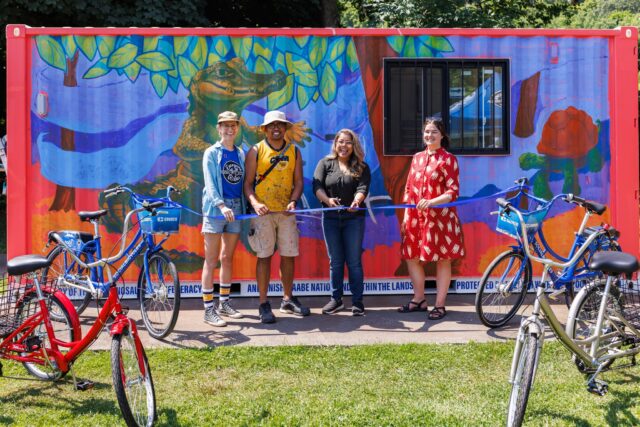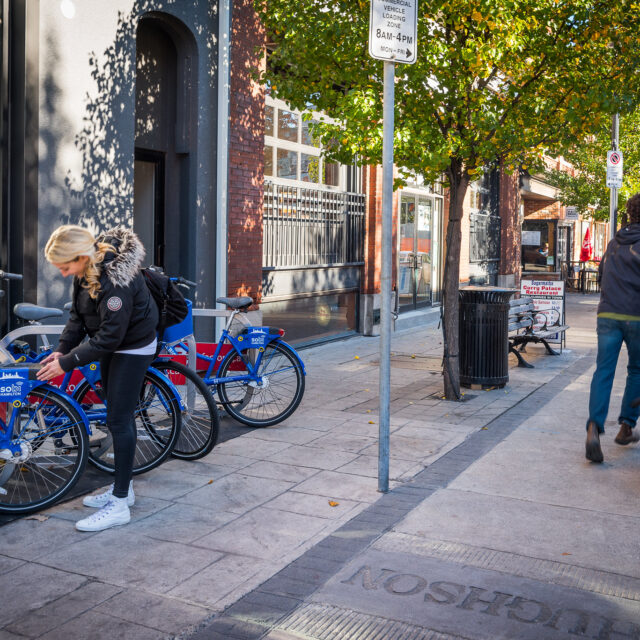An Adaptive Bike Hub in a Shipping Container
by Kiran Herbert, Communications Manager
January 18, 2023
In Hamilton, Ontario, the Everyone Rides Initiative (ERI) — the equity arm of the local bike share system — found a creative way to operate its small fleet of adaptive bikes.

Since its launch in 2015, equity has been a fundamental part of Hamilton Bike Share, the local system serving Hamilton, a Canadian city with more than half a million people. Recognizing the need to ensure social equity early on, Hamilton Bike Share created the Everyone Rides Initiative (ERI) in 2017, which offers completely free passes to those in need, with no formal documentation required.
“The whole idea behind the ERI was to serve a wide variety of people,” says Julia Hamill, ERI program manager. “It specifically exists to serve those from historically underserved communities that aren’t as well represented in the shared micromobility space.”
ERI works to remove barriers that prevent people from accessing and riding its publicly-funded system, which it sees as an extension of public transit. This includes subsidizing memberships but also offering cash payment options and conducting education and outreach efforts, such as workshops, training, group rides, and translation services. Like any good community engagement effort, a large part of all of ERI’s work relies on partnerships with different local organizations and community groups. For example, ERI works with groups that serve new immigrants to Canada, as well as those that are specifically geared towards engaging the Black community. It was the organization’s partnership with L’Arche Hamilton, however, that inspired ERI to expand on its adaptive offerings and launch a dedicated bike hub.

ERI’s ongoing relationship with L’Arche Hamilton is what prompted the creation of its adaptive hub.
“We’ve been working with L’Arche Hamilton for a while,” says Hamill, explaining that the organization supports the more than 3,000 individuals with intellectual disabilities in the Hamilton area. “We initially did some learn-to-ride-a-bike programming with some of their members and quickly found that a traditional two-wheeled bike wasn’t the best fit for everyone — it didn’t allow everyone to experience the freedom and the joy of cycling.”
Although ERI gifted one three-wheeled bike to L’Arche to use in 2019, the organization still saw a need for a more comprehensive adaptive program. That same year, ERI received a three-year grant from the Ontario Trillium Foundation and earmarked a portion of the funding to launch its adaptive bike program.
“The goal was always to have adaptive bikes available and easy to access for everyone,” says Hamill, noting that ERI eventually used the funding to purchase a fleet of four additional adaptive bikes. “We needed to figure out a location that was accessible and connected to safe cycling infrastructure, as well as a place where we could safely store the adaptive bikes.”
Because adaptive bikes are used differently and impossible to store at traditional bike hubs, ERI went about brainstorming possible solutions. Step one was figuring out where the adaptive bike hub would live: In speaking with L’Arche and other stakeholders, ERI landed on Gage Park, a safe, centrally-located recreational destination that people could get to by public transit and where they could ride without traffic.
“It would be great to have bikes at various locations in the city — and that’s definitely a goal to grow towards — but we needed to be able to start in one place,” says Hamill. “Gage Park is a really good location for us: It’s within the [Hamilton Bike Share] service area, and it’s a beautiful place to ride a bike.”
The next step was figuring out where the bikes would live. At first, ERI used a bike locker but when that proved susceptible to break-ins, began to brainstorm a more secure option. The nonprofit eventually landed on using a shipping container to store its bikes, a unique concept that’s gained traction among other nonprofits like the Ghissalo Cycling Initiative in Austin, Texas, and Rich City Rides in Richmond, California. Not only can shipping containers be made secure, but they’re also weather-proof and mobile when necessary. The shipping container ERI ultimately purchased fits all of its adaptive bikes and has extra room for select programming, as well as for storing participants’ personal belongings — including wheelchairs — while they’re out riding.

After researching, the ERI team landed on a shipping container as the ideal place to house its hub.
After figuring out permitting and a formal operating agreement with the City of Hamilton’s parks and sustainable mobility departments, ERI opened its adaptive bike hub in June of 2022. For its first season in use, the nonprofit made its two three-wheeled bikes, a cargo bike, and a pedal-assist low-step-through bike, as well as helmets, available free of charge through September 2022. While the bikes could be reserved by appointment (folks could send an email or call), many partner organizations opted to bring groups of people for recurring weekly sessions.
“For most people, it’s their first time on an adaptive bike and it can be a little different, especially if you’re used to a two-wheeled bike,” says Hamill. “It’s nice that I can go meet people and offer some tips and tricks.”
The location has also been great for hosting more programming, including learn-to-ride classes, events, and workshops. Since launching the adaptive bike hub, Hamill says ERI has been able to build and deepen partnerships with existing community organizations, including the Hamilton Council on Ageing and Cycling Without Age, two groups that serve older adults, as well as Connect Communities, a residential rehab facilitation for folks with brain injury.
“Having the [adaptive] hub has helped us strengthen existing relationships but it’s also helped us build relationships with organizations we’ve never worked with before,” says Hamill, noting that many people either found the ERI website, heard about the hub through word-of-mouth, or saw riders first-hand in Gage Park. “We’ve been able to reach people we might not have otherwise.”

The adaptive hub is allowing new users to experience the joy and freedom of riding a bike.
By all accounts, the program’s first season was a success: More than 200 rides were taken, with most lasting between one to two hours. While the hub’s size is sufficient to meet current demand, ERI hopes to be able to eventually increase its fleet offerings to include a hand cycle, a recumbent hand cycle, and a more accessible passenger cargo bike. A bigger fleet could also feed into additional locations, as well as the possibility of allowing riders to access the bikes for longer periods of time.
For other systems looking to do right by a diversity of riders, Hamill suggests reaching out to organizations and individuals in the community to see what works best for them. She also advises surveying what other systems have done, learning from them, and deciding what makes sense to do differently. And for those interested in learning more about Hamilton’s adaptive bike program, she’s always happy to chat.
“I’d love to see more adaptive programs all across the country and the world,” says Hamill. “We’ve had people find our website and reach out from other cities, so the interest and need are definitely there.”
Does your system or city have an adaptive bike program? We’d love to hear about it! Email kiran@peopleforbikes.org.



